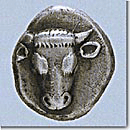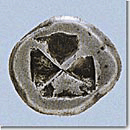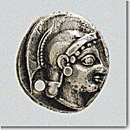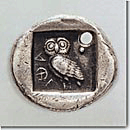






      |
|
|
Among the most important Archaic coins of the Greek mainland, both historically and artistically, were those of Athens. The first coins, the so-called heraldic or "Wappenmuenzen", must have been minted during the time of Pisistratus |
 |
 |
  |
The heraldic coins -called that way, because most scholars believe that they are related to the emblems of important families- are rare, because their series were of a limited issue. Very few times they were found outside Attica, probably because they were used mostly in local marketplaces. They are mostly didrachms and applied the Euboic standard, that is they weighed 8,5 grams approximately. They had as emblems various, though indiscernible types, such as the amphora, the glaux (i.e. owl), the horsehead, the wheel, the astragalos, the bucranium (bull's head). Yet, later, they were replaced by distinguishable national figures -such as Athena and her sacred symbol, the owl- and validated with the inscription ΑΘΕ (Athe), meaning "of Athenians", aiming at the spread of the Athenian coinage to foreign markets. |
|
| |
|
Note: Click on a picture for a brief description. | |